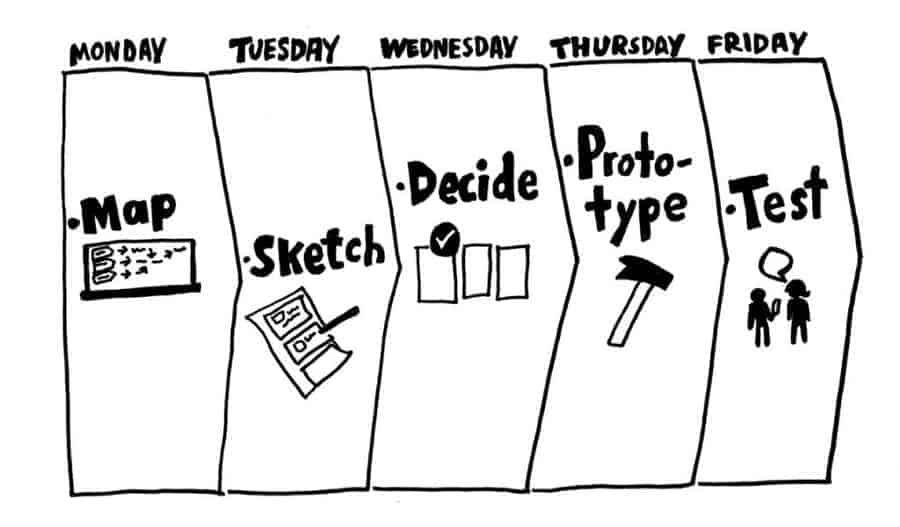5 Considerations When Deciding if a Design Sprint is Right for Your Team
If your team is considering a Design Sprint, you’re probably also considering if the cost is worth it. It’s not just a small, simple 30-minute status meeting after all. A Design Sprint is a five-day process, initially developed at Google Ventures, used for validating ideas and tackling a business problem. Teams are guided through a design thinking process to uncover insights, prototype an idea, and test it with users. Design Sprints help answer important business questions and solve big challenges through design, prototyping, and testing ideas directly with users. Benefits include team alignment (creating a shortcut to the debate cycle), less risk, and the ability to compress months of time into a single week.

If you are wondering if your team could benefit from a Design Sprint, first check out our article on 5 times you should run a Design Sprint. If and when you decide this is right for you and your team, you’ll need to consider the overall investment cost. In this post, we outline the considerations to take into account and the factors that contribute to the cost of a Design Sprint.
5 Considerations For Investing:
1) Time
This five-day process that requires careful planning. Note: we believe in giving your Design Sprint the full five days and not taking shortcuts. The activities and workshops take up the full five days, not including the pre-planning time, so you’ll want to factor that in. Consider what that means for your team – the participants will need to focus all of their time and attention on the Design Sprint, so their other projects and tasks will either need to be covered by someone else or put on hold for the week. The good news is what happens in a week can be equal to three or even six months of “regular” work.
“Design thinking research can lead to a 75% reduction in design and delivery time, often reducing an 8-month project to 3 or 4 months.” – IBM
FREE DOWNLOAD
Get Our Design Sprint Planner
Everything you need to ace your Design Sprint.
2) Resources
A Design Sprint team is typically made up of seven people who will provide diverse and critical perspectives on the project (including a Facilitator, Decider, Sponsor, some mix of Experts, Prototypers, Designers, Product and Tech leads). As mentioned above, this Sprint team will be fully focused on the Design Sprint over the five days, therefore their time and salary are factors to consider. In addition to time and salary, any other projects they are working on should also be factored into consideration.
3) Complexity
The complexity and impact of the project will also be a factor in the overall cost. For example, redesigning an existing piece of product functionality will likely be more straightforward than conceptualizing net new functionality from the ground up, and therefore requires less planning, time and resources. First decide on what the overarching challenge or question is that you hope to solve by utilizing a Design Sprint. Then you will have a more informed way to determine cost based upon the complexity of that challenge.

4) Expert Facilitators
Another consideration that will factor into the overall cost will be deciding to hire an expert facilitator or using someone internally. Consider bringing in an expert facilitator when dealing with big or sensitive topics. They offer a non-biased opinion, are removed from office politics, and take care of logistics while making sure everyone stays on track. The facilitator’s role is to increase engagement and positivity in the group, and an outside facilitator is a fresh face who can help to break patterns and promote productivity. Alternatively teams can run Design Sprints on their own, if there’s a neutral leader in the group who is well-versed in the process and facilitation.
Looking for someone to run a Design Sprint for you? We can help!
5) In-Person vs. Virtual
A final consideration and cost variable, especially relevant in today’s environment, is if the Design Sprint will be in-person or virtual. Traditionally, they have been held with all participants attending in-person, but they don’t have to be. Virtual Design Sprints can be just as effective but must be treated differently, as they are in a completely different landscape. If you decide to hold the Design Sprint in-person, you’ll need to consider travel, lodging and event costs if everyone is not located in the same place.
If you decide to go the virtual route, we recommend moving at a slower pace and scheduling a series of mini-workshops as opposed to five full days of activities. These mini workshop sessions are built chronologically one after the other. This sequence could happen over the course of four days, or even eight if needed. Combined, they create the complete virtual Design Sprint calendar. Designing around the in-between times is powerful and an opportunity that in-person doesn’t support. Between each mini-workshop, we assign homework and set the expectation that they will present their work at the next group session. Setting the expectation that the participant will present creates social pressure to encourage participation and ensure the work gets done. It’s easier for participants to get distracted during a virtual gathering, therefore it’s even more important for the Facilitator to pay attention to participant engagement and be proactive in including everyone in each activity.

We Think It Is Worth It!
Design Sprints can seem daunting, especially when thinking of all the immediate investment costs. But you also are getting a positive return on investment – lots of ideas and experiments in a relatively short period of time. Think about the long term – what you could be risking by continuing to do things the way they’ve always been done.
Consider these reasons why a Design Sprint is a sound investment:
- Accomplish a month’s worth of work in 1 week
- Get user feedback before it’s too late
- Improve visibility & alignment for your team
- Gain speed & momentum for your project
- Foster a culture of innovation
Learn how we helped IDB Invest’s Technology team improve its customer engagement and experience with a Design Sprint.
The true financial benefit of a Design Sprint is the upfront decision-making and alignment, resulting in a more efficient and simplified future process and product. By helping your company or team find the deep value for the end-user before building anything, and removing potentially useless or time-consuming features, you can save your team months of design, engineering, and development work and costs. You will be able to get your product or idea to market more quickly. Considering that Design Sprints minimize risk, reduce time to market, and accelerate innovation, we believe it’s worth the time and money when done correctly.
You Don’t Have to Design Sprint Alone
If you want to run a Design Sprint at your company but are overwhelmed by the idea of planning and facilitating it, we can help you. Voltage Control designs and leads sprints for companies large and small. Having a professional facilitator run your Design Sprint ensures that you can focus on the ideas and the work, not the logistics or “doing it right.” Reach out to us at hello@voltagecontrol.com or get in touch with us here if you want to talk about running a Design Sprint at your company.



